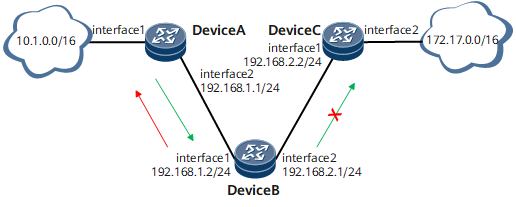Layer 3 Loop Detection Fundamentals
Once a loop occurs on a Layer 3 network, packets cannot be forwarded normally, bringing great loss to carriers or users.
As shown in Figure 1, the route to 172.17.0.0/16 on Device A points to Device B, and the route to 172.17.0.0/16 on Device B does not point to Device C but unexpectedly to Device A. In this case, a routing loop is formed between Device A and Device B. Packets sent from Device A and Device B to 172.17.0.0/16 are looped between Device A and Device B and finally are sent to the CPUs of Device A and Device B for processing because of TTL timeout.
Layer 3 loop detection collects and analyzes statistics about TTL timeout packets sent to the CPU. By performing tracert operations to the destination IP addresses of these TTL timeout packets, Layer 3 loop detection determines whether a routing loop occurs and reports a trap, if detecting a routing loop, to notify the NMS of the IP address that generates the loop.

Currently, Layer 3 loop detection is supported on the IPv4 public network.
